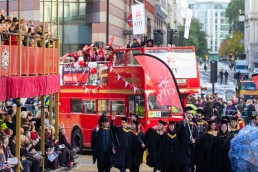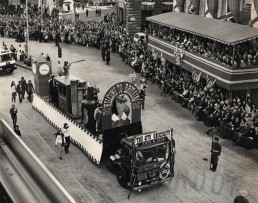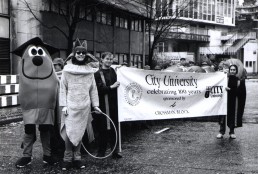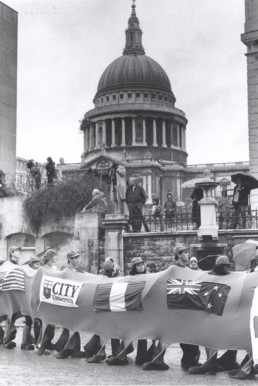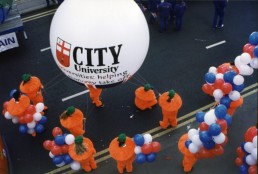The Lord Mayor’s Show is a celebration that takes place annually in London and dates back to 1215. For over 50 years, City has played a proud part in the event, flying the flag for its role in the City of London.
City is linked to the office of the Lord Mayor as the holder of the role serves as the University’s Rector, or in years gone by the University’s Chancellor. The Lord Mayor is one of the oldest elected civic offices in the world, with the holder representing, supporting and promoting the businesses and residents of the City of London.
It began when King John persuaded the City of London to support him in his struggle with his brother Richard’s chancellor, Longchamps. In return for that support, John granted a commune to the citizens, with the chief officer given the title of Mayor.
Henry Fitz Alwyn was the first post holder in 1189 and was mayor for 24 years. King John’s Charter of 1215 ensured that it would become a democratically elected role. Whoever was elected would be presented to the King for his approval, to whom he must swear loyalty.
Dick Whittington held the post of Lord Mayor three times – in 1397, 1406 and 1419.
During the medieval period, there were different ceremonies and processions. Pagan traditions were important in the early years of the show, with the inclusion of wicker giants Gog and Magog, who were guardians of the City, placed in the Guildhall after being used in the parade.
The Lord Mayor’s Show evolved from this ritual and would see the Lord Mayor escorted from his residence at Mansion House to the Royal Courts of Justice, where the oath to the monarch had been sworn since 1883. In 1928, Edward I decided that the Mayor could present himself to the Constable of the Tower rather than the monarch. Today, the judges of the Queen’s Bench Division hear the oath.
During the early days, there were two different routes for the procession. One was a then country road called Strand, which was flanked by the houses of the Dukes of Somerset and Savoy, now Somerset House and the Savoy Hotel. The other route was by river, with a barge transporting the Lord Mayor along the Thames. The final time that a City barge was built to transport a Lord Mayor to Westminster was in 1807, with the final river procession taking place in 1856.
By land, the important members of the parade rode on horseback. The Lord Mayor travelled by coach after 1711, when Sir Gilbert Heathcote fell from his horse and broke his leg. The New Grand State Coach was designed by Sir Robert Taylor in 1757 and it is still used today. It is a Berlin style rather than Grand Carosse style coach. Painted panels on the coach depict allegorical figures of Truth, Temperance, Justice and Fortitude.
In 1761, Prime Minister William Pitt took part, drawing huge crowds, with some even rushing up to kiss his horses. A notable occasion during the Lord Mayor’s Show was in 1876, when 13 elephants were part of the event to celebrate the Empire.
Senior ceremonial units of the British army are given permission by the Queen to participate in the event, including the King’s Troop and Royal Horse Artillery. The Mounted Band of the Household Cavalry Regiment ride in their Gold Sate Coats, the only time that they do so when they are not in the presence of royalty. In recent years the Lord Mayor’s Show has started with a fly-past, with RAF ‘planes trailing coloured smoke flying 1,500 feet above Mansion House. While its formal role may have become less important, a re-imagining of the event ensured it remained relevant in the 20th century. More organisations became involved in the proceedings in the period following World War II. Modern themes for the show see the Lord Mayor seeking to create a visual representation of intentions for the year ahead.
As a key part of the City of London community, students from City have participated in the Lord Mayor’s Show for decades, designing floats and ornate costumes. In 1966, a float that would acknowledge the new scientific departments was constructed, featuring an oversized computer – that was perhaps only slightly bigger than the real computers of the era.
In 1969, Brian Burns designed City’s float, which led the procession that was themed to encourage tourists to visit Britain.
“The elements that made up the design were supposed to represent Britain. So behind the arched sign that said ‘Welcome to Britain’ was a Scottish reference, which was the Loch Ness Monster, also Industrial Midlands – as it was then – represented by chimneys,” Brian recalled.
“On the left side was a terrible Welsh reference, fishing for whale/Wales, while London was represented by the corner of a double decker bus. I also remember a British businessman with an umbrella standing under a rain shower.”
He explained that it was students who put the floats together: “There were always engineering students keen to make it all work… very practical people and the Students’ Union was very positive. I think the time frame was a matter of four or five weeks.”
Later floats lacked the complication of those from the 1960s, focusing more on costumes and allowing more students to get involved and walk the parade route. In 1993, students dressed as a centipede for the occasion and in 1996, they dressed as carrots to represent the Students’ Union mascot.
In recent years, City has been represented by a classic London open top bus, with City students and staff taking up the top deck or walking alongside it, continuing the tradition of City’s participation in the Lord Mayor’s Show.
The peculiarly British mix of ceremony, pageantry and tradition, combined with a forward looking, modern outlook makes the Lord Mayor’s Show a one-of-a-kind event, which will no doubt continue to evolve in the years ahead.
